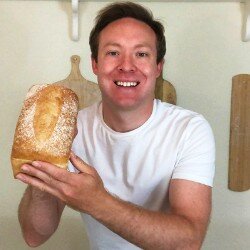
Why Pricing Bread Is Such A Challenge!

I can’t lie. I had no idea how much to charge for a loaf of bread when I opened my first bakery. I had some dreams of “perceived value” and “loss leaders”, etc. But they were just dreams. In reality, I had no clue.
Not knowing if you are charging the right amount for your product doesn’t help anxiety levels. It is exceptionally stressful when you don’t know your profit margins!
There are many things that you should be focusing on when your bakery starts trading, such as generating sales and building your brand. You don’t want to be analysing and changing prices!
I discovered this the hard way.
After a couple of months of trading and using my “finger in the air” costing technique, I hooked up with a business mentor. My mentor’s advice for calculating my selling price was:
“Add all of the costs of production and add on 60% to get your price”
Like a good boy, I followed his guidance and adapted the shop prices to compensate.
“Good boy Gareth!”
And I found this generic strategy worked, but only to an extent.
When it came to my business making a profit, I still fell short.
I got a bit stuck with his costing method when it came to accurately charge for each product. It didn’t seem right that my brioche rolls were four times the price of standard rolls.
My customers thought so too. They are not that much more expensive in other shops. How could I get the price down because they were not going to sell at the price I calculated?!
After seeing a need to increase my prices, I did
I didn’t want to be seen as money-grabbing. I wanted to be affordable so everyone could enjoy my bread, but the evidence didn’t lie. I had to increase my prices. Otherwise, the bakery would end up closing.
Changing the prices wound up my customers. It especially pissed off the ones who had supported me from opening week. We’d only had a handful of customers a day, so I really valued their support. I lost a few customers.
But still had my worries about the costing method
No matter what I tried to do to get the costing model that my mentor had explained to work, I just didn’t feel the prices were right. I’d be selling a roll for the same price as a loaf, a pizza would cost pence, and my brioche was an absolute fortune – No-wonder it didn’t sell too well!
So I had to find another way to price bread.
How most businesses work the for-sale price
The common way to work out the selling price is to add the ingredients and production labour costs together, which gives you the cost of sales. Then a 60-80% profit margin is included to pay further costs and for profit.
The profit margin is usually industry-specific. For example, in car manufacturing, the profit margin will be higher to compensate for the design, testing, improvement and infrastructure costs. Whereas in a restaurant, costs are lower and more consistent, so the profit margin is lower.
Other costs, such as utilities, equipment, rent etc., are placed in the fixed costs and not in the costing of the products. When working out how much to charge for a product, the business owner will take the expected yearly sales in a spreadsheet and work out a sweet spot between how many units they will be sold and how much the fixed costs will be.
Further reading: Is a bakery business profitable?
Why costing bakery products is different
Bread has an incredibly low ingredient cost. The cost of enough flour, water, salt, and yeast to make a loaf of bread is in pennies. Actually, if you buy your ingredients in bulk, many loaves cost single digits.
The cost of labour, power used to bake the bread, distribution, and rent will be the majority of your expenses.
Owning a bakery is not just about making good bread. To have a successful bread operation, you need to be an expert in selling, marketing, logistics and, above all, managing your costs.
This standard method of calculating business cost does work, but it gets confusing when calculating the price of bread sold in relatively small volumes. Especially when starting from scratch.
I have found that to have a good pricing strategy for bread. You should accurately compensate for the fixed costs as well as the traditional costs of sales. Only then can you charge for your products with confidence.
After I made a better costing method
Once I put a costing strategy that included the fixed costs into the price of the bread, the pricing of my bread became a strength, not a weakness. In my new wholesale business, I could expand without fear of overstretching myself or losing money in certain areas.
I no longer had to worry about the price. This meant I could concentrate (finally) on growing my business!
If you’ve enjoyed this article and wish to treat me to a coffee, you can by following the link below – Thanks x

Hi, I’m Gareth Busby, a baking coach, senior baker and bread-baking fanatic! My aim is to use science, techniques and 15 years of baking experience to make you a better baker.
Table of Contents
Related Recipes
Related Articles
Latest Articles
Baking Categories
Disclaimer
Address
53 Greystone Avenue
Worthing
West Sussex
BN13 1LR
UK








Leave a Reply